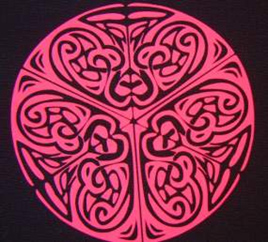How do you determine if one brand of heat transfer film is better than another? Today, most flex films are polyurethane. But not all polyurethane films are the same. In fact, the difference from one brand to another is staggering. Here’s what to look for in comparative shopping:

In evaluating cutting and weeding characteristics, put the candidate products to an extreme test. A design with fine detail will help you rate the performance of the different films.
FLEXIBILITY. All polyurethane stretches more than vinyl. This characteristic is critical, because fabrics stretch. And the popular performance fabrics, such as DriFit and UnderArmour, stretch significantly more than traditional textiles. In making your selection, test the various brands side by side to see which is more stretchable after the applique is applied to the garment.
SOFTNESS OF HAND. The old heat transfer vinyls were stiff as a board, and just as uncomfortable. Some polyurethane films are nearly as stiff. Comparing products simply involves touching the applied graphics to decide which film has a softer hand.
CUTTING, WEEDING & HANDLING. Many flex films have a tacky pressure sensitive carrier or backing sheet. The tacky carrier makes cutting and weeding easier. In testing products, you should rate the films based on cutting and weeding characteristics. After weeding the films, stack one finished graphic on top of another. Ideally, stacked graphics pull apart easily with no damage.
LAYERING. Some brands of heat transfer films have limitations when heat pressing one color on another. On this matter, you need to ask the suppliers whether you can layer any color on top of another and if there are any problems in layering particular colors.
ADHESION TO FABRIC. Testing the adhesion of the film to fabric is one of the most important criteria. After transferring the films, stretch the fabric to the extreme and pick at the edges to determine at what point will the product fail. In evaluating the adhesion of products to various fabrics, keep in mind that special fabrics require special adhesive solutions. For example, some of the new performance fabrics and coated surfaces require heat transfer films with adhesives designed for those specific applications. Your supplier can help you select the right product for the application.
DURABILITY. Polyurethane appliques are durable. They will withstand washing after washing. Unlike vinyl transfers, polyurethane won’t crack. With proper care, polyurethane heat transfers should last the life the garment. The test that I have used in evaluating products is to apply the various candidate films on the same fabric, and after washing the garment multiple times, rate the performance.
Note: PVC heat transfer films are often considerably less expensive than polyurethane films. These films are thicker, less flexible and less durable than polyurethane. After multiple washings, PVC heat transfer graphics tend to become brittle and crack.
ECOLOGICAL REQUIREMENTS. Ask your suppliers whether their heat transfer films have been tested for harmful substances as well as what test standards were used in the evaluation. If you are a shop owner in the United States, you should also find out if the films satisfy CPSIA requirement for lead in children’s article
About the author . . .
Jim Hingst, is a recognized authority in the field of vinyl graphics application. In Vinyl Sign Techniques, Hingst provides a comprehensive guide to the vinyl graphics business. Built around his firsthand experiences working for major fleet graphics screen printers and pressure sensitive manufacturers, Hingst offers a perspective on the vinyl business that thoroughly covers sales and marketing, materials, fabrication, and installation and removal of vinyl products of all kinds. Vinyl Sign Techniques has something for everybody in the vinyl graphics business. Hingst’s book, provides ideas and techniques for graphics fabricators and installers along with advice for executives and salespeople that will result in higher sales and profits.
As seen on hingstssignpost.blogspot.com.


